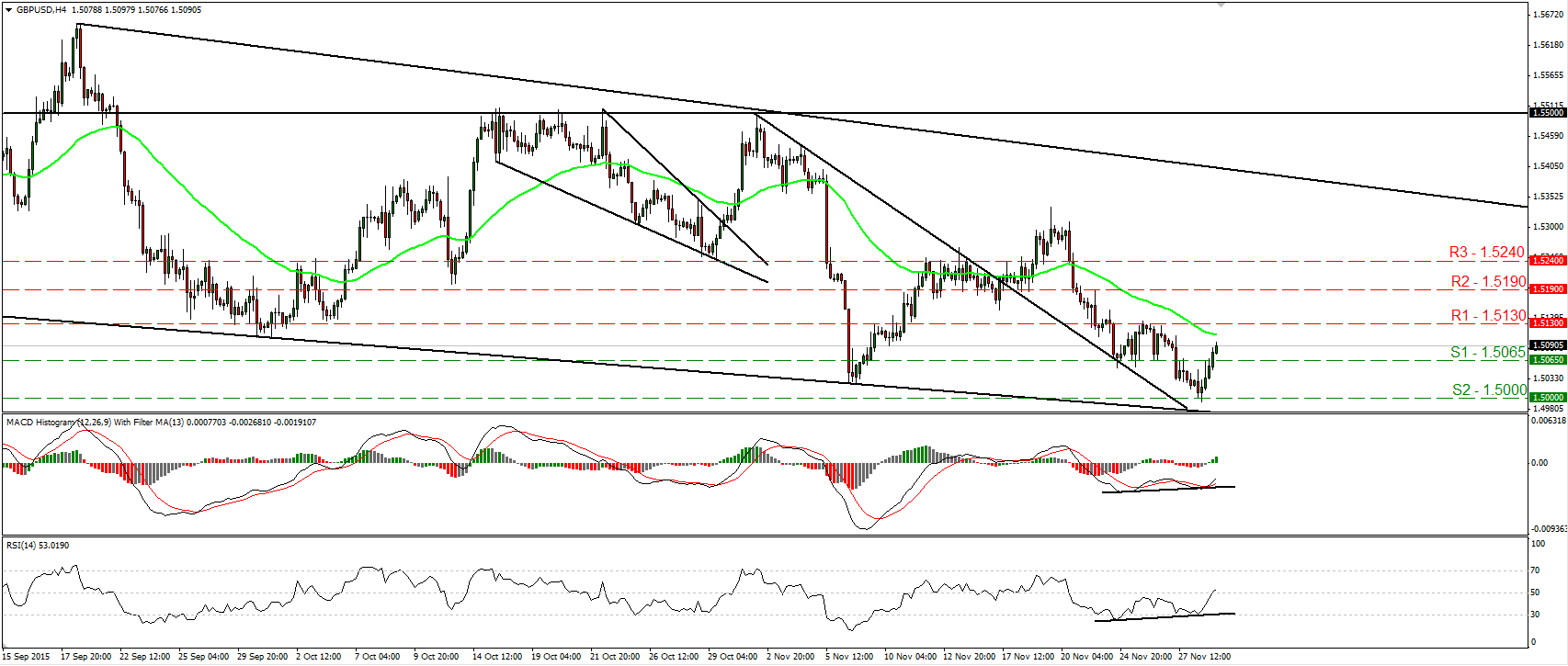RBA leaves rates unchanged The Reserve Bank of Australia kept its key interest rates unchanged as was widely expected, amid signs of improvement of business conditions over the past year and a stronger growth in employment. It signaled however that low inflation may afford scope for further easing of policy. The statement accompanying the decision was virtually unchanged from the previous one, with the tone staying neutral to slightly positive. Nevertheless, the recent strength in the AUD on a trade-weighted basis, despite the falling iron ore prices, could encourage the RBA Governor Glenn Stevens to resume talking down the currency. In today’s statement, Bank officials reiterated their stance that the Australian dollar is adjusting to the significant declines in key commodity prices. However, with the iron ore prices (Australia’s main export) hitting new lows while the AUD is relatively stable, this relationship shows signs of divergence. As a result, if the AUD continues to strengthen and iron ore prices continue to fall, the RBA officials could reintroduce talks to weaken their currency in their next meetings. Governor Stevens did said that the markets should “chill out” on prospects of another rate cut, and the markets did so with no major reaction from AUD at this event. We remain cautious on further appreciation of AUD against the dollar and we would prefer to exploit Aussie’s strength against its New Zealand counterpart.
• The International Monetary Fund agreed on Monday to add the Chinese yuan to its reserve currency basket. The inclusion – effective next October – represents recognition that the yuan’s status is rising along with China’s place in global markets. This is, however, in large part symbolic. Whether the yuan will be used by central banks as reserve currency will highly depend on China’s success in deepening its financial system, promote financial reforms, and the currency being more “freely tradable.”
• Today’s highlights: During the European day, we get the final manufacturing PMIs for November from several European countries and the Eurozone as a whole. As usual the final forecasts for the PMIs are the same as the initial estimates, thus the market reaction on these news is usually limited, unless we have a huge revision from the preliminary figures. From Germany, in addition to the final manufacturing PMI, the unemployment rate for November is expected to have remained unchanged at a record low level of 6.4%. Eurozone’s unemployment rate for October is also to be released.
• From the UK, we get the manufacturing PMI for November, which is expected to have decreased moderately. This could prove GBP-negative.
• In the US, the ISM manufacturing PMI and the final Markit manufacturing PMI, both for November are also due out. The market pays more attention to the ISM index, which following its third consecutive decline in October and reaching its lowest level since 2013, is expected to have increased in November. This could support the greenback somewhat.
• From Canada we get the quarterly GDP data for Q3 and the monthly GDP figure for September. The market expects the annualized quarterly rate to expand at a 2.3% qoq pace after contracting 0.5% qoq in Q2, escaping from technical recession. While the monthly rate is forecast to decline to 0%. The weak monthly print in August and a possible weak print in September however, along with the low commodity prices raise questions on how the Q3 figure as a whole could improve. As a result, we could see a disappointment at today’s release, which could put the loonie under renewed selling pressure. We also get the RBC manufacturing PMI for November but no forecast is available.
• We have three speakers on Tuesday’s agenda: BoE Governor Mark Carney and Chicago Fed President Charles Evans speak.
The Market
EUR/USD finds support at 1.0560
• EUR/USD traded marginally lower yesterday, but hit support at 1.0560 (S1) and then it rebounded somewhat. The short-term trend remains negative in my view and therefore, I would expect a clear move below 1.0560 (S1) to open the way for the next support obstacle of 1.0530 (S2), defined by the lows of the 13th and 14th of April. Taking a look at our short-term oscillators though, I see signs that a minor corrective bounce could be on the cards before the bears decide to shoot again. The RSI rebounded from near its upside support and 30 lines, while the MACD, although negative, has bottomed and just poked its nose above its trigger line. In the bigger picture, as long as the pair is trading below 1.0800, the lower bound of the range it had been trading since the last days of April, I would consider the longer-term outlook to stay negative. I would treat any possible near-term advances that stay limited below 1.0800 as a corrective phase.
• Support: 1.0560 (S1), 1.0530 (S2), 1.0500 (S3)
• Resistance: 1.0630 (R1), 1.0670 (R2), 1.0710 (R3)
GBP/USD triggers some buy orders near 1.5000
• GBP/USD traded lower yesterday during the European morning, but trigger some buy orders near the psychological zone of 1.5000 (S2) and then it rebounded strongly. The rate is currently trading above the 1.5065 (S1) barrier and I would expect the positive move to continue and perhaps challenge the 1.5130 (R1) line. A break above that zone could set the stage for more upside extensions towards the next resistance of 1.5190 (R2). Our short-term oscillators corroborate my view. The RSI rebounded from its 30 line and then it emerged above its 50 line, while the MACD, although negative, has bottomed and crossed above its trigger line. What is more, there is positive divergence between both these indicators and the price action. On the daily chart, the price structure remains lower peaks and lower troughs. Therefore, I still consider the longer-term trend to be cautiously negative and I would treat any further extensions of the current rebound as a corrective move, at least for now.
• Support: 1.5065 (S1), 1.5000 (S2), 1.4960 (S3)
• Resistance: 1.5130 (R1), 1.5190 (R2), 1.5240 (R3)
AUD/USD turns up and hits 0.7285
• AUD/USD traded higher on Monday and continued to do so during the Asian morning Tuesday after the RBA decided to keep its benchmark interest rate unchanged and reiterated that the prospects for an improvement in economic conditions had firmed a little over recent months. The rate emerged above the resistance (now turned into support) barriers of 0.7215 (S2) and 0.7240 (S1), and hit our resistance of 0.7285 (R1), defined by the high of the 25th of November. Following the completion of an inverted head and shoulders on the 18th of November, I still believe that the short-term outlook remains cautiously positive. After all, the rate is still trading above the uptrend line taken from the low of the 10th of November. A clear move above 0.7285 (R1) is likely to confirm a forthcoming higher high on the 4-hour chart and perhaps open the way for the next obstacle of 0.7345 (R2). Switching to the daily chart, I see that AUD/USD still oscillates between 0.6900 and 0.7400 since mid-July. As a result, although the short-term uptrend may continue, I would hold a flat stance for now as far as the broader trend is concerned.
• Support: 0.7240 (S1), 0.7215 (S2), 0.7160 (S3)
• Resistance: 0.7285 (R1), 0.7345 (R2), 0.7380 (R3)
Gold rebounds and hits resistance at 1074
• Gold traded higher on Monday, breaking back above the resistance (now turned into support) barrier of 1065 (S1). A break above that level is likely to signal the upside exit of a downside channel that has been containing the price action since the 4th of November and could initially aim for the 1080 (R1) resistance zone, marked by the peak of the 25th of November. Our short-term oscillators have turned up, supporting that further advances could be looming in the short run. The RSI edged higher after exiting its oversold territory and managed to overcome its 50 line, while the MACD has bottomed, crossed above its trigger line, and is now headed towards its zero line. On the daily chart, I see that the plunge below the upside support line taken from the low of the 20th of July has shifted the medium-term outlook to the downside. As a result, I believe that the metal is poised to continue its down road in the foreseeable future. I would treat any further upside waves as a corrective phase for now.
• Support: 1065 (S1), 1055 (S2), 1050 (S3)
• Resistance: 1074 (R1), 1080 (R2), 1088 (R3)
DAX futures look ready to pull back
• DAX futures traded higher on Monday, but hit our resistance barrier of 11420 (R1) and then they retreated somewhat. Although the short-term picture is still positive, given that the price tested the upside resistance line taken from the peak of the 23rd of November, I would expect the index to pull back for now. Perhaps to challenge again the support of 11260 (S1). A break below that support could aim for the 11160 (S2) line. Our short-term momentum indicators provide evidence that a retreat could be in the works as well. The RI hit resistance at its 70 line and turned down, while the MACD, although positive, has topped and could fall below its trigger line soon. On the daily chart, the break above the psychological zone of 10500 on the 22nd of October signalled the completion of a double bottom formation. What is more, the rebound on the 16th of November from that psychological area adds to my view that the medium-term path remains positive.
• Support: 11260 (S1), 11160 (S2), 11040 (S3)
• Resistance: 11420 (R1), 11630 (R2), 11800 (R3)





